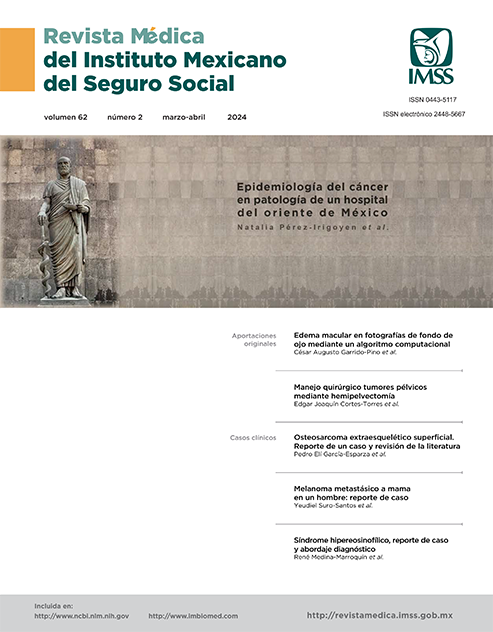Surgical management of pelvic tumors through hemipelvectomy
Main Article Content
Keywords
Mortality, Recurrence, Osteosarcomas, Hemipelvectomy
Abstract
Background: Primary malignant bone tumors are rare however, have a high global mortality rate. Osteosarcoma and chondrosarcoma are the most common bone sarcomas in the pelvis. The surgical management of primary bone tumors in the pelvis is challenging and depends on several factors. Internal hemipelvectomy with extremity preservation has become more popular compared to external hemipelectomy.
Objective: Identify and describe characteristics of the surgical management of bone tumors and soft tissues of the pelvis by means of hemipelvectomy.
Material and methods: Observational study of consecutive cases, in which patients with bone and soft tissue tumors undergoing hemipelvectomy were identified from January 2010 to December 2020 at the Oncology Surgery Department, using the Musculoskeletal Tumor Society (MSTS) scale.
Results: 17 patients with pelvic tumors were included, 10 (58.8%) primary bone sarcomas, 3 (17.6%) soft tissue sarcomas, 3 (17.6%) benign bone tumors, 1 (5.8%) neoplasia of hematological origin. Average follow-up of 30 ± 14. Most frequent surgical complication, surgical wound seroma, 6 patients (37.5%).
Conclusions: A multidisciplinary team is required to individualize treatment with the best sequence of options, giving improvement in oncological and functional results.
References
Qu Y, Li X, Yan Z, et al. Surgical planning of pelvic tumor using multi-view CNN with relation-context representation learning. Med Image Anal. 2021;69:101954. doi: 10.1016/j.media.2020.101954.
Lee JS, Kelly CM, Bartlett EK. Management of pelvic sarcoma. Eur J Surg Oncol. 2022;48(11):2299-2307. doi: 10.1016/j.ejso.2022.09.011
Benady A, Gortzak Y, Sofer S, et al. Internal Hemipelvectomy for primary bone sarcomas using intraoperative patient specific instruments- the next step in limb salvage concept. BMC Musculoskelet Disord. 2022;23(1):1012. doi: 10.1186/s12891-022-05918-1.
McColl M, Fayad LM, Morris C, et al. Pelvic bone tumor resection: what a radiologist needs to know. Skeletal Radiol. 2020;49(7):1023-1036. doi: 10.1007/s00256-020-03395-y.
Benatto MT, Hussein AM, Gava NF, et al. COMPLICATIONS AND COST ANALYSIS OF HEMIPELVECTOMY FOR THE TREATMENT OF PELVIC TUMORS. Acta Ortop Bras. 2019;27(2):104-107. doi: 10.1590/1413-785220192702206721.
Revuri VR, Moody K, Lewis V, et al. Pain and Analgesia in Children with Cancer after Hemipelvectomy: A Retrospective Analysis. Children (Basel). 2022;9(2):237. doi: 10.3390/children9020237
Ahlawat S, McColl M, Morris CD, et al. Pelvic bone tumor resection: post-operative imaging. Skeletal Radiol. 2021;50(7):1303-1316. doi: 10.1007/s00256-020-03703-6.
Karaca MO, Özbek EA, Özyıldıran M, et al External and internal hemipelvectomy: A retrospective analysis of 68 cases. Jt Dis Relat Surg. 2022;33(1):132-141. doi: 10.52312/jdrs.2022.560.
Mallet J, El Kinani M, Crenn V, et al. French translation and validation of the cross-cultural adaptation of the MSTS functional assessment questionnaire completed after tumor surgery. Orthop Traumatol Surg Res. 2023;109(3):103574. doi: 10.1016/j.otsr.2023.103574.
Brown HK, Schiavone K, Gouin F, et al. Biology of Bone Sarcomas and New Therapeutic Developments. Calcif Tissue Int. 2018;102(2):174-195. doi: 10.1007/s00223-017-0372-2.
Harris MA, Hawkins CJ. Recent and Ongoing Research into Metastatic Osteosarcoma Treatments. Int J Mol Sci. 2022;23(7):3817. doi: 10.3390/ijms23073817.
Weinschenk RC, Wang WL, Lewis VO. Chondrosarcoma. J Am Acad Orthop Surg. 2021;29(13):553-562. doi: 10.5435/JAAOS-D-20-01188.
Shin KH, Rougraff BT, Simon MA. Oncologic outcomes of primary bone sarcomas of the pelvis. Clin Orthop Relat Res. 1994;(304):207-17.
Chow W, Frankel P, Ruel C, et al. Results of a prospective phase 2 study of pazopanib in patients with surgically unresectable or metastatic chondrosarcoma. Cancer. 2020;126(1):105-111.
Hesla AC, Papakonstantinou A, Tsagkozis P. Current Status of Management and Outcome for Patients with Ewing Sarcoma. Cancers (Basel). 2021;13(6):1202. doi: 10.3390/cancers13061202.
Soto DJ. Ewing’s sarcoma in Pediatric pelvis. Literature review. Science and Health Magazine. 2022;6(1): 25-40.
Sacco R, Lalevée M, Pellegrino P, et al. Soft tissue sarcomas of the buttock: A systematic review and meta-analysis. Surg Oncol. 2022;45:101883. doi: 10.1016/j.suronc.2022.101883.
Aksnes LH, Bauer HC, Jebsen NL, et al. Limb-sparing surgery preserves more function than amputation: a Scandinavian sarcoma group study of 118 patients. J Bone Joint Surg Br. 2008;90(6):786-94. doi: 10.1302/0301-620X.90B6.19805.
Renard AJ, Veth RP, Schreuder HW, et al. Function and complications after ablative and limb-salvage therapy in lower extremity sarcoma of bone. J Surg Oncol. 2000;73(4):198-205.
Chao AH, Neimanis SA, Chang DW, et al. Reconstruction After Internal Hemipelvectomy. Annals of Plastic Surgery 2015;74(3): 342-349.
Jamshidi K, Zandrahimi F, Bagherifard A, et al. Type lll internal hemipelvectomy for primary bone tumours with and without allograft reconstruction: a comparison of outcomes. Bone Joint J. 2021;103-B(6):1155-1159. doi: 10.1302/0301-620X.103B6.BJJ-2020-2149.R1.
Mayerson JL, Wooldridge AN, Scharschmidt TJ. Pelvic Resection. Am Acad Orthop Surg. 2014;22(4):214-22.
Kar BK, Kumar-Yadav S, Venishetty N, et al. Internal Hemipelvectomy and Pelvic Reconstruction With Non-Vascularized Fibular Graft for Chondrosarcoma Ilium. Cureus. 2021;13(7):e16292. doi: 10.7759/cureus.16292.
Banskota N, Yang H, Fang X, et al. Comparative study of pelvic sarcoma patients undergoing internal and external hemipelvectomy: A meta-analysis study. Front Surg. 2022;9:988331. doi: 10.3389/fsurg.2022.988331.
Brown JM, Rakoczy K, Hart J, et al. Presenting features and overall survival of chondrosarcoma of the pelvis. Cancer Treat Res Commun. 2022;30:100510. doi: 10.1016/j.ctarc.2022.100510.


